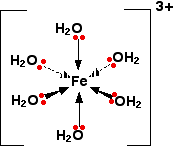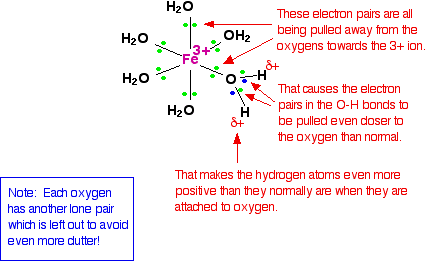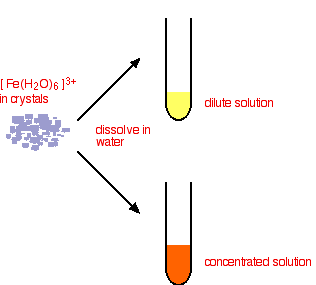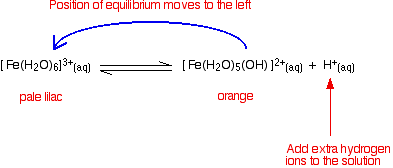8.2: Acidity of the Hexaaqua Ions
- Page ID
- 40118
This page explains why complex ions of the type [M(H2O)6]n+ are acidic.
The Charge Distribution within Complex Ion
Hexaaqua ions are what they sound like: a metal-ligand complex in which a central metal ion is surrounded by six water molecules acting as ligands, with each oxygen atom sharing one of its unshared pairs of electrons with the central metal ion. While the pH's of solutions containing such ions vary a lot from one metal to another (assuming you are comparing solutions of equal concentrations), they all tend to exhibit properties of an acid. The underlying explanation is the same for all of them.
We'll take the hexaaquairon(III) ion, [Fe(H2O)6]3+ as typical. The structure of the ion is:

Each of the six water molecules are attached to the central iron(III) ion via a co-ordinate bond using one of the two lone pairs on the oxygen. We'll choose one of these water molecules at random and look at the bonding in a bit more detail - showing all the bonds around the oxygen including its two hydrogen atoms. Imagine for the moment that the 3+ charge is located entirely on the iron.

When the lone pairs on the oxygens form co-ordinate bonds with the iron, there is obviously a movement of electrons towards the iron atom. That has an effect on the O-H bond's electrons, which in turn get pulled towards the oxygen even more than usual. That leaves the hydrogen nuclei more exposed than normal. The overall effect is that each of the hydrogen atoms is more positive than it is in ordinary water molecules. The 3+ charge is no longer located entirely on the iron but spread out over the whole ion - much of it on the hydrogen atoms at the edge of the coordination sphere.
The behavior of this ion in water
The hydrogen atoms attached to the water ligands are sufficiently positive that they can be pulled off in a reaction involving water molecules in the solution. The first stage of this process is:
\[ \ce{ Fe(H2O)6^{+3} + H_2O <=> Fe(H2O)5(OH)^{+2} + H_3O^{+}} \label{eq1}\]
The complex ion is acting as an (Arrhenius) acid by donating a hydrogen ion to water molecules in the solution to form hydronium ions. The water is, of course, acting as a (Arrhenius) base by accepting the hydrogen ion. Because of the confusing presence of water from two different sources (the ligands and the solution), it is easier to simplify Equation \ref{eq1}:
\[ \ce{[Fe(H_2O)_6]^{+3}_{(aq)} \rightleftharpoons [Fe(H2O)_5(OH)]^{+2}_{(aq)} + H^{+}_{(aq)}} \label{eq2}\]
However, if you write it like this, remember that the hydrogen ion is not just falling off the complex ion. It is being pulled off by a water molecule in the solution. Whenever you write "\(H^+(aq)\)" what you really mean is a hydroxonium ion, H3O+.
Finally, these reactions are sometimes written as if the water molecules surrounding the central metal ion are not there, and that instead of donating protons, they are picking up hydroxide ions as ligands. For example:
\[ \ce{Fe^{+3}_{(aq)} + OH^{-}_{(aq)} \rightleftharpoons Fe(OH)^{+2}_{(aq)} } \label{eq3}\]
The hexaaquairon(III) ion is quite strongly acidic giving solutions with pH's around 1.5, depending on concentration. You can get further loss of hydrogen ions as well, from a second and a third water molecule since the complex ion is a polyprotic acid. So, the central iron atom appears to be surrounded by an increasing number of hydroxide ions instead of the water molecules originally present. We would represent these additional reactions as follows:
\[ \ce{Fe(OH)^{+2}_{(aq)} + OH^{-}_{(aq)} \rightleftharpoons Fe(OH)_2^{+}_{(aq)} } \label{eq4}\]
\[ \ce{Fe(OH)_2^{+}_{(aq)} + OH^{-}_{(aq)} \rightleftharpoons Fe(OH)_{3(aq)} } \label{eq5}\]
In the final case, we are left with a neutral complex. It may persist to some extent in water, but because it has no charge, it may be sparingly soluble and will be in equilibrium with its solid-phase precipitate form.
In practice
What do you actually get in solution if you dissolve an iron(III) salt in water? In fact you get a mixture of all the complexes that you have seen in the equations above. These reactions are all equilibria, so everything will be present. The proportions depend on how concentrated the solution is and whether the pH is controlled by other molecules in solution.
The color of an iron(III) salt solution is variable and depends in part on the concentration of the solution; dilute solutions can be pale yellow, while more concentrated ones are much more orange and may even produce some orange precipitate. None of these colors represents the true color of the [Fe(H2O)6]3+ ion - which is a very pale lilac color and is only really easy to see in solids containing the ion.

Looking at the equilibrium showing the loss of the first hydrogen ion:
\[ \underbrace{\ce{ Fe(H2O)6^{3+}}}_{\text{pale lilac}} + \ce{H2O} \ce{<=>} \underbrace{\ce{Fe(H2O)5(OH)^{2+}}}_{\text{orange}} + \ce{H3O^{+}}\]
The color of the new complex ion on the right-hand side is so strong that it completely masks the color of the hexaaqua ion. In concentrated solutions, the equilibrium position will be even further to the right-hand side (Le Chatelier's Principle), and so the color darkens. You will also get significant loss of other hydrogen ions (Equation \ref{eq4} and \ref{eq5}) leading to some formation of the neutral complex and thus some precipitate.
The position of this equilibrium can be shifted by adding extra hydrogen ions from a concentrated acid (e.g., by adding concentrated nitric acid to a solution of iron(III) nitrate). The new hydrogen ions push the position of the equilibrium to the left so that you can see the color of the hexaaqua ion. This is slightly easier to follow if you write the simplified version of the equilibrium (Equation \ref{eq2}).

3+ Ions are More Acidic than 2+ ions
Solutions containing 3+ hexaaqua ions tend to have pH's in the range from 1 to 3. Solutions containing 2+ ions have higher pH's - typically around 5 - 6, although they can go down to about 3. Remember that the reason that these ions are acidic is because of the pull of the electrons towards the positive central ion. An ion with 3+ charges on it is going to pull the electrons more strongly than one with only 2+ charges.
In 3+ ions, the electrons in the O-H bonds will be pulled further away from the hydrogens than in 2+ ions. That means that the hydrogen atoms in the ligand water molecules will have a greater positive charge in a 3+ ion, and so will be more attracted to water molecules in the solution. If they are more attracted, they will be more readily lost - and so the 3+ ions are more acidic.


